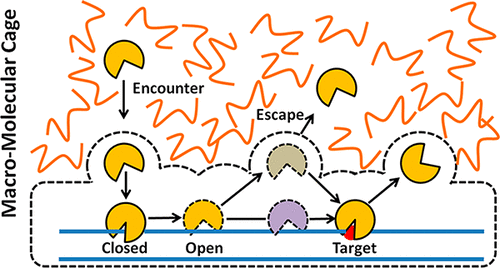当前位置:
X-MOL 学术
›
Chem. Rev.
›
论文详情
Our official English website, www.x-mol.net, welcomes your
feedback! (Note: you will need to create a separate account there.)
Facilitated Diffusion Mechanisms in DNA Base Excision Repair and Transcriptional Activation.
Chemical Reviews ( IF 51.4 ) Pub Date : 2018-10-31 , DOI: 10.1021/acs.chemrev.8b00513 Alexandre Esadze 1 , James T Stivers 1
Chemical Reviews ( IF 51.4 ) Pub Date : 2018-10-31 , DOI: 10.1021/acs.chemrev.8b00513 Alexandre Esadze 1 , James T Stivers 1
Affiliation

|
Preservation of the coding potential of the genome and highly regulated gene expression over the life span of a human are two fundamental requirements of life. These processes require the action of repair enzymes or transcription factors that efficiently recognize specific sites of DNA damage or transcriptional regulation within a restricted time frame of the cell cycle or metabolism. A failure of these systems to act results in accumulated mutations, metabolic dysfunction, and disease. Despite the multifactorial complexity of cellular DNA repair and transcriptional regulation, both processes share a fundamental physical requirement that the proteins must rapidly diffuse to their specific DNA-binding sites that are embedded within the context of a vastly greater number of nonspecific DNA-binding sites. Superimposed on the needle-in-the-haystack problem is the complex nature of the cellular environment, which contains such high concentrations of macromolecules that the time frame for diffusion is expected to be severely extended as compared to dilute solution. Here we critically review the mechanisms for how these proteins solve the needle-in-the-haystack problem and how the effects of cellular macromolecular crowding can enhance facilitated diffusion processes. We restrict the review to human proteins that use stochastic, thermally driven site-recognition mechanisms, and we specifically exclude systems involving energy cofactors or circular DNA clamps. Our scope includes ensemble and single-molecule studies of the past decade or so, with an emphasis on connecting experimental observations to biological function.
中文翻译:

DNA碱基切除修复和转录激活中的促进扩散机制。
保留人类基因组中的基因组编码潜力和高度调控的基因表达是生命的两个基本要求。这些过程需要修复酶或转录因子的作用,这些酶必须在细胞周期或新陈代谢的有限时间内有效识别DNA损伤或转录调控的特定位点。这些系统无法发挥作用会导致累积的突变,代谢功能障碍和疾病。尽管细胞DNA修复和转录调控具有多种复杂性,但这两个过程都具有基本的物理要求,即蛋白质必须迅速扩散到其特定的DNA结合位点,该位点嵌入在大量非特异性DNA结合位点的背景下。叠加在大海捞针上的问题是细胞环境的复杂性质,其中包含如此高的大分子浓度,因此与稀溶液相比,预计扩散时间会严重延长。在这里,我们批判性地回顾了这些蛋白质如何解决“大海捞针”问题的机制,以及细胞大分子拥挤的作用如何增强便利的扩散过程的机制。我们将审查限于使用随机的,热驱动的位点识别机制的人类蛋白质,并且我们特别排除涉及能量辅因子或环状DNA钳夹的系统。我们的研究范围包括过去十年左右的整体和单分子研究,重点是将实验观察结果与生物学功能联系起来。
更新日期:2018-10-31
中文翻译:

DNA碱基切除修复和转录激活中的促进扩散机制。
保留人类基因组中的基因组编码潜力和高度调控的基因表达是生命的两个基本要求。这些过程需要修复酶或转录因子的作用,这些酶必须在细胞周期或新陈代谢的有限时间内有效识别DNA损伤或转录调控的特定位点。这些系统无法发挥作用会导致累积的突变,代谢功能障碍和疾病。尽管细胞DNA修复和转录调控具有多种复杂性,但这两个过程都具有基本的物理要求,即蛋白质必须迅速扩散到其特定的DNA结合位点,该位点嵌入在大量非特异性DNA结合位点的背景下。叠加在大海捞针上的问题是细胞环境的复杂性质,其中包含如此高的大分子浓度,因此与稀溶液相比,预计扩散时间会严重延长。在这里,我们批判性地回顾了这些蛋白质如何解决“大海捞针”问题的机制,以及细胞大分子拥挤的作用如何增强便利的扩散过程的机制。我们将审查限于使用随机的,热驱动的位点识别机制的人类蛋白质,并且我们特别排除涉及能量辅因子或环状DNA钳夹的系统。我们的研究范围包括过去十年左右的整体和单分子研究,重点是将实验观察结果与生物学功能联系起来。











































 京公网安备 11010802027423号
京公网安备 11010802027423号